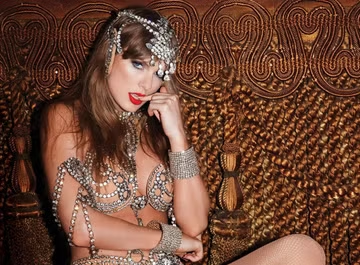Taylor Swift has never been just a songwriter. She’s a storyteller, a myth-maker, and a master of layering personal truths inside pop anthems. With her twelfth studio album, The Life of a Showgirl, she pulls the curtain back on her most theatrical era yet—an album equal parts dazzling spectacle and intimate confession. Released at midnight, the project instantly sparked a frenzy of decoding, as fans scoured lyrics for hidden clues, subtle shade, and visions of her future with NFL star Travis Kelce. What they found was Swift at her sharpest, her most vulnerable, and her most unapologetically playful.
The album wastes no time in setting the tone. On “Actually Romantic,” Swift revives the side of herself fans lovingly call “petty Taylor.” The track flips expectations, steering away from romance and instead skewering a longtime nemesis. “It’s actually sweet, all the time you spent on me,” she sings, her voice laced with irony. The lyrics read like a clapback to someone consumed with tearing her down, likening their obsession to a form of devotion. Industry whispers point toward Charli XCX as the possible subject, but Swift never names names, leaving just enough mystery to keep the internet buzzing.
From pettiness to tenderness, Swift pivots into “Wishlist,” a song that feels ripped from her private daydreams. Here she speaks candidly about wanting a family with Kelce, eschewing Hollywood extravagance in favor of simple joys: kids who look like him, a driveway with a basketball hoop, and a love untouched by fame. The honesty is striking. For an artist who once questioned marriage, these lyrics sound like a woman who has not only embraced love but imagined its future.
Not every track is about romance, however. “Ruin the Friendship” pulls the album into somber territory. Rather than chronicling betrayal, it mourns someone she lost, filled with regret for words never spoken. It’s Swift at her most stripped down—no hidden daggers, just raw grief. The song has become a standout for fans who connect with its aching simplicity and its reminder that fame doesn’t shield anyone from loss.
If grief defines one corner of the record, defiance defines another. In “Cancelled,” Swift unleashes a Reputation-era firestorm in defense of a friend caught in the unforgiving cycle of public shaming. “Good thing I like my friends cancelled, dripped in Gucci and in scandal,” she spits, reclaiming loyalty as her weapon. Listeners speculate that this may nod to Blake Lively, who has recently faced legal controversies and, by extension, dragged Swift’s name into headlines. Whether or not that theory is true, the track serves as a manifesto of solidarity. For Swift, true friendship means scars shared, not secrets kept.

Then there are the songs that document her romance with Travis Kelce—tracks that feel almost prophetic. On “Elizabeth Taylor,” she questions forever while playing with the imagery of diamonds and Hollywood glamour. “Opalite” references Kelce’s birthstone, describing him as the rainbow that cleared her skies. “Honey” reclaims an endearment once used to diminish her, transforming it into a term of intimacy when spoken by the right person. And “Eldest Daughter” reads like a vow, with Swift promising unwavering loyalty to the people she loves. “When I said I don’t believe in marriage, that was a lie,” she admits, a revelation that feels both personal and universal.
Of all the Kelce-inspired tracks, none is bolder than “Wood.” Equal parts sultry and cheeky, the song sees Swift embracing intimacy without euphemism. “Love was the key that opened my thighs,” she sings, her playfulness balanced with certainty. The track ends with a sly wink toward her engagement ring: “I don’t need to catch the bouquet to know a hard rock is on the way.” It’s a declaration of passion, permanence, and a confidence that feels worlds away from the heartbreak ballads of her past.
What makes The Life of a Showgirl remarkable is its duality. On the surface, the title suggests sequins, feathers, and over-the-top theatricality. And yes, the album sparkles with drama. But beneath that glitter is a deeply personal record about loyalty, love, loss, and desire. It’s an album where Swift allows herself to be silly, spiteful, romantic, and mournful—all at once.
As with every Swift project, Easter eggs are everywhere. From lyrical nods to Elizabeth Taylor’s many marriages to opal imagery linking Kelce’s birthstone to destiny, fans are piecing together a web of connections that stretch across Swift’s discography and personal life. The brilliance lies in her ability to keep the narrative alive long after release day. Each lyric doubles as both a personal truth and a puzzle piece in the Taylor Swift universe.
More than anything, though, this album proves Swift is still capable of reinvention without losing her essence. Twelve albums in, she hasn’t grown timid. If anything, Showgirl is bolder, more intimate, and more unapologetically Swift than ever before. She is a woman in love, a friend fiercely loyal, a star unafraid to spar with enemies, and an artist still writing her story in real time.
In the end, The Life of a Showgirl isn’t just a collection of songs—it’s a performance of selfhood, a declaration of who Taylor Swift is right now. And if history has taught us anything, it’s that these songs will one day mark another turning point in her ever-evolving mythology.
For now, one thing is clear: Taylor Swift is still the master of turning her life into art, and with The Life of a Showgirl, she has given the world another glittering, complicated, unforgettable chapter.








